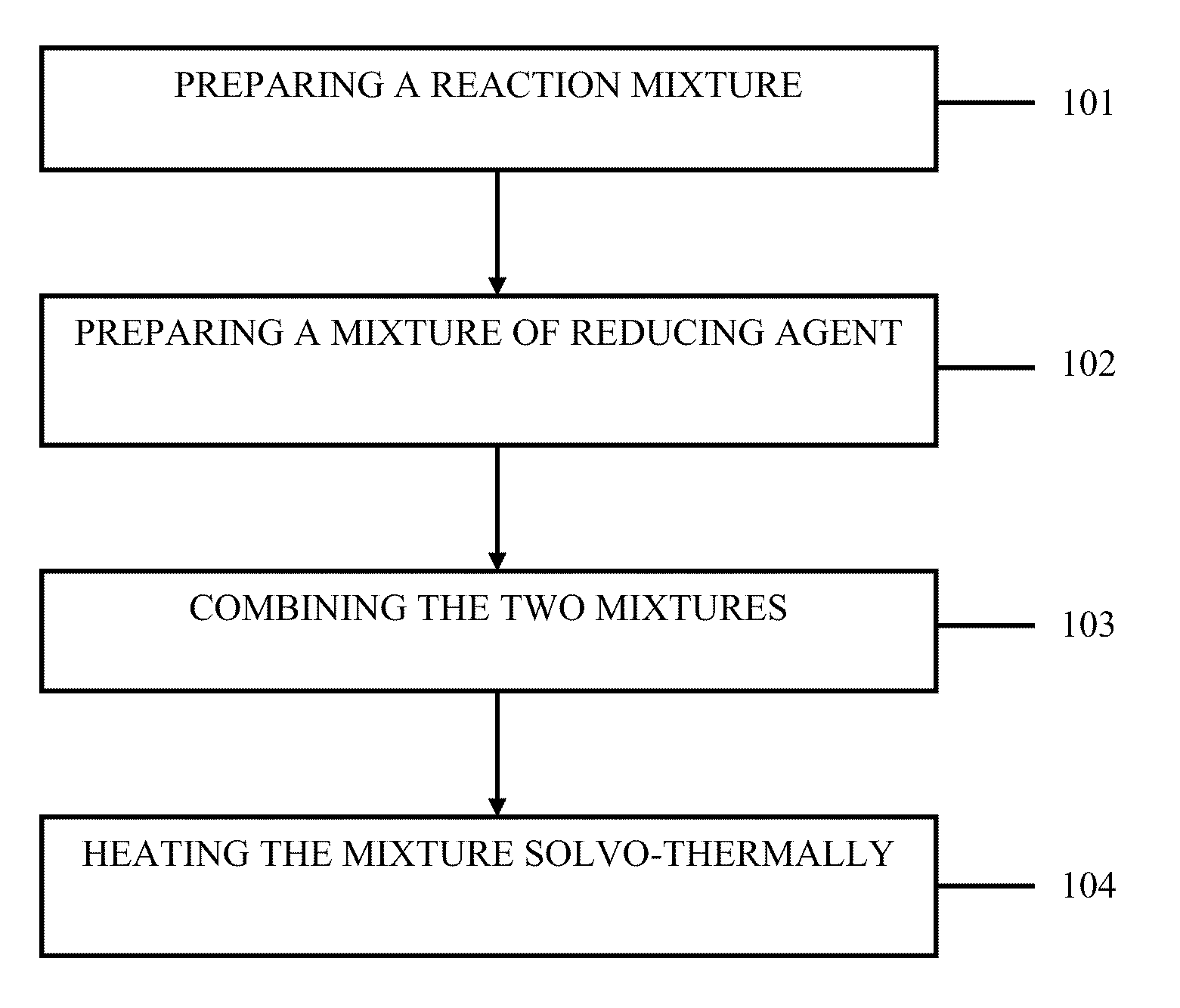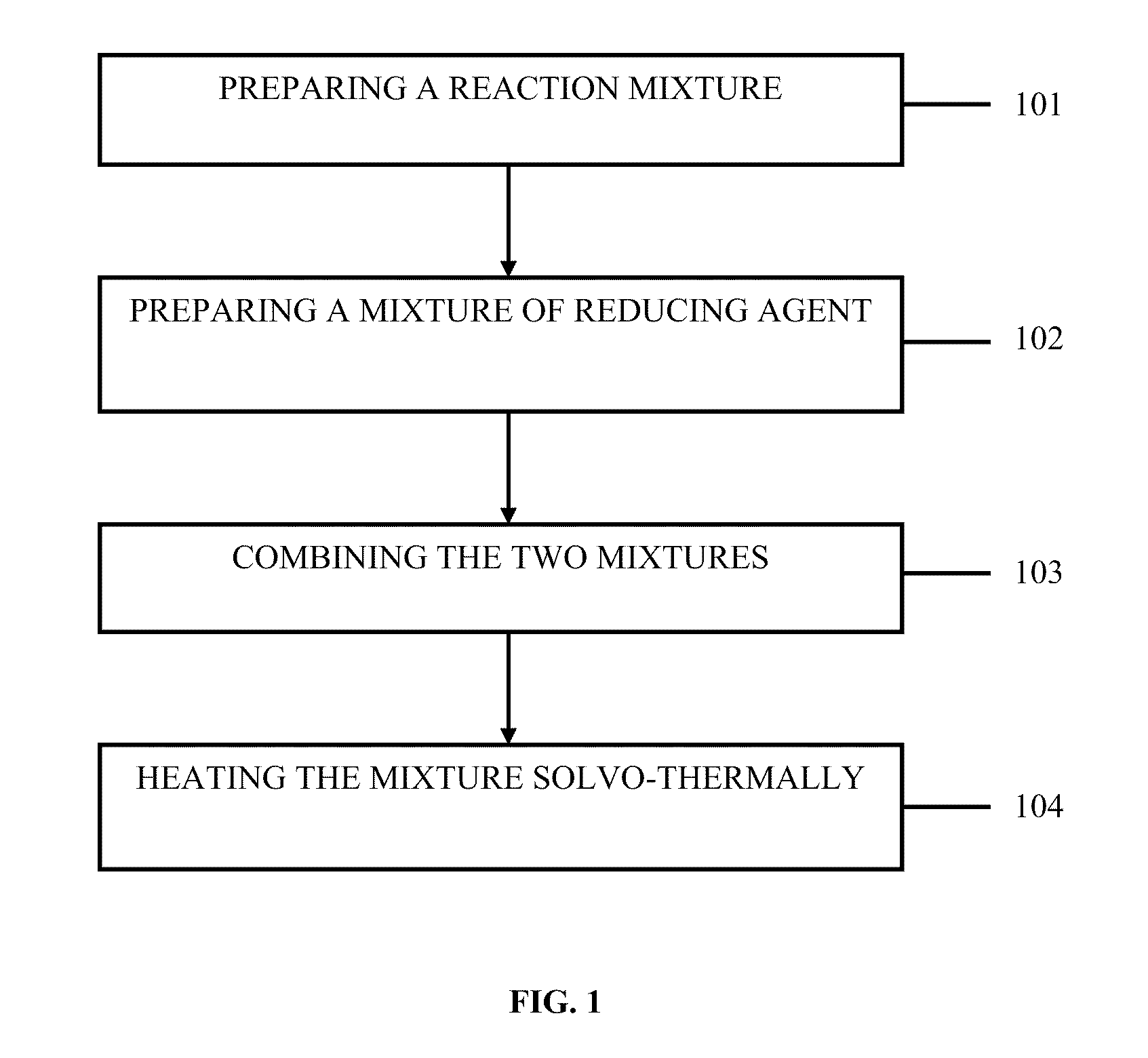Method for the sysnthesis of metallic NANO products
- Summary
- Abstract
- Description
- Claims
- Application Information
AI Technical Summary
Benefits of technology
Problems solved by technology
Method used
Image
Examples
example # 1
Example#1
[0281]1 ml from 1 mM to 5 mM HAuCl4.3H2O and 10 mL to 50 mL stearic acid were dissolved and mixed in 40 mL to 90 mL diethyl ether and heated to 80° C.-110° C. The color of the reaction solution was changed to green color. In a separate flask, 50 mL to 100 mL stearic acid was dissolved in 10 mL to 30 mL diethylether and heated to 70° C.-90° C. for 10 min to be used as a reducing solvent. Subsequently, the reducing solvent was injected into the mixture. The mixture was held at 150° C. for 30 min until the reduction was complete (visually, the color of the solution was changed to brown). After the reaction, the solution containing gold nanoparticles was cooled to room temperature. Ethanol was then added to precipitate gold nanoparticles. After washing several times with ethanol, the precipitated gold nanoparticles were collected for analysis. After 2 hours of the reaction, re-precipitation was performed using a polar solvent a mixture of acetone and methanol. (The reaction tem...
example # 2
Example#2
[0282]1 ml from 1 mM to 10 mM HAuCl4.3H2O and 10 mL to 50 mL stearic acid were dissolved and mixed in 50 mL to 100 mL Methanol and heated to 100° C.-150° C. The color of the reaction solution was changed to green color. In a separate flask, 5 mL to 10 mL stearic acid was dissolved in 10 mL to 50 mL Methanol and 10 mL to 50 mL Acetic acid and heated to 80° C.-100° C. for 10 min to be used as a reducing solvent. Subsequently, the reducing solvent was injected into the mixture. The mixture was held at 150° C. for 30 min until the reduction was complete (visually, the color of the solution was changed to brown). After the reaction, the solution containing gold nanoparticles was cooled to room temperature. Ethanol was then added to precipitate gold nanoparticles. After washing several times with ethanol, the precipitated gold nanoparticles were collected for analysis. After 2 hours of the reaction, re-precipitation was performed using a polar solvent a mixture of acetone and met...
example # 3
Example#3
[0283]1 ml from 1 mM to 10 mM HAuCl4.3H2O and 30 mL to 80 mL stearic acid were dissolved and mixed in 40 mL to 100 mL Chloroform and heated to 80° C.-100° C. The color of the reaction solution was changed to green color. In a separate flask, 10 mL to 30 mL stearic acid was dissolved in 10 mL to 50 mL Chloroform and heated to 80° C. for 10 min to be used as a reducing solvent. Subsequently, the reducing solvent was injected into the mixture. The mixture was held at 120° C. for 30 min until the reduction was complete (visually, the color of the solution was changed to brown). After the reaction, the solution containing gold nanoparticles was cooled to room temperature. Ethanol was then added to precipitate gold nanoparticles. After washing several times with ethanol, the precipitated gold nanoparticles were collected for analysis. After 2 hours of the reaction, re-precipitation was performed using a polar solvent a mixture of acetone and methanol. (The reaction temperature of...
PUM
| Property | Measurement | Unit |
|---|---|---|
| Temperature | aaaaa | aaaaa |
| Temperature | aaaaa | aaaaa |
| Time | aaaaa | aaaaa |
Abstract
Description
Claims
Application Information
 Login to View More
Login to View More - R&D
- Intellectual Property
- Life Sciences
- Materials
- Tech Scout
- Unparalleled Data Quality
- Higher Quality Content
- 60% Fewer Hallucinations
Browse by: Latest US Patents, China's latest patents, Technical Efficacy Thesaurus, Application Domain, Technology Topic, Popular Technical Reports.
© 2025 PatSnap. All rights reserved.Legal|Privacy policy|Modern Slavery Act Transparency Statement|Sitemap|About US| Contact US: help@patsnap.com



